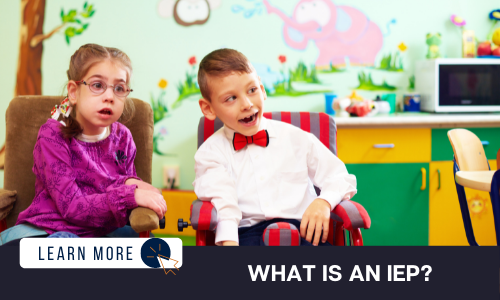What is an IEP?
 |
 |
Full Guide of all 30+ Flyers (Compiled as a Booklet)
Versión en Español en Formato PDF: ¿Qué es un IEP?
What is an IEP?
IEP stands for Individualized Education Program. It is a “road map” to guide you and your child’s school in meeting your child’s needs. The IEP consists of education goals. It includes a list of special education services and disability accommodations to meet your child’s needs. The IEP team writes the IEP. You are a key member of the team!
When will the IEP be created and updated?
The IEP team makes the IEP after the school has done an evaluation for your child. The evaluation is key. Your child will get an IEP only if the team determines that your child is eligible for special education services. The initial IEP must be in place within 60 school days of the beginning of the evaluation process. The IEP team will meet at least once a year to review and update your child’s IEP.
What is an IEP team?
An IEP team is a group that meets at least once a year to create or update your child’s IEP. The school can write a draft of the IEP before the meeting. As a parent, you should ask for a copy of the draft IEP prior to the meeting. That draft is discussed in the meeting. As a parent, your input must be considered. You and your child are the most important members of the IEP team.
Learn more: Who can make a referral for an evaluation to determine if my child needs Special Education services?
Who is on the IEP team?
• The parent(s) of the child must be on the IEP team
• The student must be included if they are 14 or older. They can be included if they are younger than 14
• At least one special education teacher must be on the IEP team
• At least one general education teacher must be on the IEP team
• At least one school representative that can provide or supervise special education services and that has knowledge of the general education curriculum and the school’s resources must be on the IEP team
• This could be a principal, assistant principal, school psychologist, or someone else
• Other school representatives may attend based on your child’s specific needs
• A person who can interpret the results of your child’s evaluations must attend
• This person may also be part of the evaluation team
• You and the school can invite other people to the meeting. These people are known as others with special knowledge or expertise about the child. We recommend that you bring one or more people that also have knowledge about your child’s needs. Don’t go alone. You do not need permission from the school to bring others with you to the meeting.
The IEP meeting intimidates me. What else should I know?
We agree that these meetings may seem intimidating at first. However, your participation in the IEP meeting is very important to the success of your child in school. You know your child best. You are an equal partner on the IEP team. You must be a part of each decision the IEP team makes about your child’s services. You help the team know your child’s strengths, needs, interests, abilities, and history. Please contact Families Together and the Disability Rights Center of Kansas for more tips on how to make IEP team meetings a success.
It can help to see an example of an IEP. See one example here.
Sources & Additional Resources
What should an IEP include? Disability Rights Center of Kansas & Families Together, Inc.
How can I advocate for my child at an IEP meeting? Disability Rights Center of Kansas & Families Together, Inc.
What can I do if my child's IEP is not working? Disability Rights Center of Kansas & Families Together, Inc.
How does my child qualify for an IEP? Disability Rights Center of Kansas & Families Together, Inc.
Kansas Special Education Process Handbook. Kansas State Department of Education.
.png)





